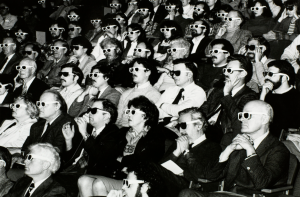Chapter 6: Thinking Rhetorically
6.1. Audience
Monique Babin, Carol Burnell, Susan Pesznecker, Nicole Rosevear, Jaime Wood

“Theater audience wearing 3-d glasses” by Burns Library, Boston College is licensed under CC BY-NC-ND 2.0
Each time you communicate, in writing or otherwise, you consider whom you’re communicating with and why, whether you’re conscious of this or not. Think about it: if you’re asking your best friend for a favor, aren’t you going to ask differently than if you were asking your boss for a raise? You already have a great instinct for knowing how to shape language around the people you are addressing and what your goal is. So how can you use this instinct when writing for your college classes?
A roaring political rally, a studio audience, dancing concert goers—these are all examples of different types of audiences, but an audience for your writing is a bit different. All audiences have a job to do: they are consumers of information or experiences. So when you set out to write, deciding who your audience is, is an important first step.
What is the Difference between an Audience and a Reader?
Great question! It’s as simple as this: your audience is the person or group whom you intend to reach with your writing. A reader is just someone who gets their hands on your beautiful words. The reader might be the person you have in mind as you write, the audience you’re trying to reach, but they might be some random person you’ve never thought of a day in your life. You can’t always know much about random readers, but you should have some understanding of who your audience is. It’s the audience that you want to focus on as you shape your message.
Isn’t My Instructor Always My Audience?
Sometimes your instructor will be your intended audience, and your purpose will be to demonstrate your learning about a particular topic to earn credit on an assignment. Other times, even in your college classes, your intended audience will be a person or group outside of the instructor or your peers. This could be someone who has a personal interest in or need to read about your topic but who may never actually read your work unless it finds a place to be published like a blog or website. Understanding who your intended audience is will help you shape your writing.
Here are some questions you might think about as you’re deciding what to write about and how to shape your message:
- What do I know about my audience? (age, gender, interests, biases, or concerns; Do they have an opinion already? Do they have a stake in the topic?)
- What do they know about my topic? (What does this audience not know about the topic? What do they need to know?)
- What details might affect the way this audience thinks about my topic? (How will facts, statistics, personal stories, examples, definitions, or other types of evidence affect this audience? What kind of effect are you going for?)

